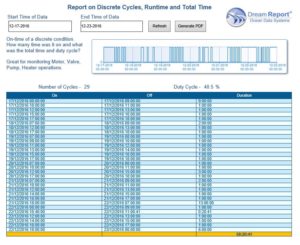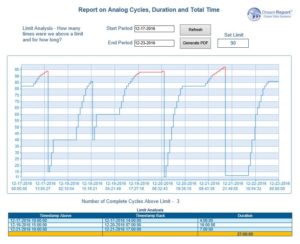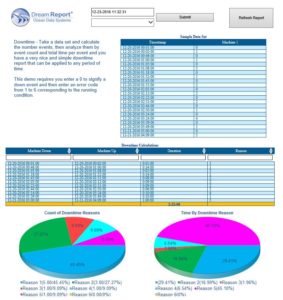There are many attributes of Dream Report that make it special. But when asked “What is the most powerful aspect of Dream Report?”, the answer is in how it processes data into informative results.
There are many steps to delivering information. Dream Report excels in each category:
- Data Interfaces – Dream Report delivers over 70 interfaces; proprietary drivers to products, automation industry standard and business standard interfaces. With its broad range of interfaces, Dream Report is sure to interface with your data sets. When you generate a report or dashboard, Dream Report will query the source and process that data into results. Trigger it again, and it does it again. No duplication of data, no temporary repositories of data.
- Data Storage – If you have data archives, Dream Report will use them directly. It’s all about one version of the truth. If you don’t have archives, then Dream Report will store data into the database of your choosing, and will report from that repository. Data storage is straight forward and powerful. Set real-time tags to log, define logging based on time, event, update or change. Enable logging based on other conditions. Limit database sizes and automatically create working backup files of older data. It’s about managing data repositories automatically, so you don’t need to.
 Turning raw data into results – A lot of the Magic is found here. It’s not about taking this value and that and performing basic math. It’s about stepping through data sets by time, by value, by batch and summarizing those sets into steps in a table, bars in a graph, trends in a chart, or delivering a simple one value result. Dream Report knows how to step. It knows how to handle automation data – quality, timestamps, missing data, rollover values… If your reports are very simple – get this value and report it – not a problem and you can use Dream Report for that, but when the going gets tough, you’ll appreciate the special, built in and “take for granted” capabilities of Dream Report. We’ll describe this more later…
Turning raw data into results – A lot of the Magic is found here. It’s not about taking this value and that and performing basic math. It’s about stepping through data sets by time, by value, by batch and summarizing those sets into steps in a table, bars in a graph, trends in a chart, or delivering a simple one value result. Dream Report knows how to step. It knows how to handle automation data – quality, timestamps, missing data, rollover values… If your reports are very simple – get this value and report it – not a problem and you can use Dream Report for that, but when the going gets tough, you’ll appreciate the special, built in and “take for granted” capabilities of Dream Report. We’ll describe this more later…- Formatting the results – Is the value flawed? Highlight it in red, make it bold, compare it with last week’s value, last month’s value, the last batch value. Putting it in context will make it actionable. Need real-time dashboards? Represent data as graphs, gages and color and text mapping, dynamic images and more.
- Deliver the results – Email it, FTP it, print it, save the results to a directory, an excel file or a csv file. Post the results to a Web Portal for all (with proper authorization) to access. Let users interact with the results – drill down, change dates and times of interest, pan and zoom charts, search and sort tables, export data for further analysis.
The areas listed above are all strong points for Dream Report. One of the most unique however, is the ability to create data sets and analyze them for the delivery of information. Examine the following real world questions:
 What is our pump cycle time, number of starts and total run-time over the past week?
What is our pump cycle time, number of starts and total run-time over the past week?- How many times did we surpass this energy use and what was the total time for last December?
- What was our Downtime for the last shift and what were the counts by reason and the total time by reason?
- Let’s summarize the last 10 batches and select the max, min and average for these variables.
- I need a graph of year to date energy use over last year’s energy use. How do the totals compare?
In vertical markets, the calculations become more specific and sometimes – more complex…
- We want a Thermal Uniformity Survey report. Show the heat treat cycle and graph all sensors. Validate that they meet the distribution requirements, total heat treat soak times, for these setpoint steps.
- We are storing and shipping thermally sensitive material. Calculate the Mean Kinetic Temperatures over the entire process.
- We are sterilizing sensitive product. What is the F0 calculation for this batch?
- We have energy meters and want to totalize weekly, monthly and yearly totals by department. The meter values roll over at 65535 and need to be accounted for automatically.
- Need to calculate BTU efficiency of our building and totalize CO2 Also generate annual costs.
 We are backwashing our filters and need Turbidity values one hour before and one hour after a backwash. What was the maximum Turbidity each day and when did it happen? Also, what was the minimum Chlorine residual each day and when did it happen?
We are backwashing our filters and need Turbidity values one hour before and one hour after a backwash. What was the maximum Turbidity each day and when did it happen? Also, what was the minimum Chlorine residual each day and when did it happen?- Just a small sample of the many common questions easily answered by Dream Report…
Dream Report delivers the objects and the configuration ability to address these and many more data scenarios.
For the greatest convenience and most productivity, these calculations should be performed and distributed to the correct audience, automatically. Results need to be archived so users can quickly gage year over year, batch to batch, etc. changes.
That, in a nutshell, is the magic of Dream Report. Easy to learn, quick to apply, with no programming or scripting. It has the power to generate the statistics you are looking for, automatically, and will have them waiting for you when you want them. Still not sure? Contact our Sales@DreamReport.net for a discussion and tailored demonstration, specific to your application.

